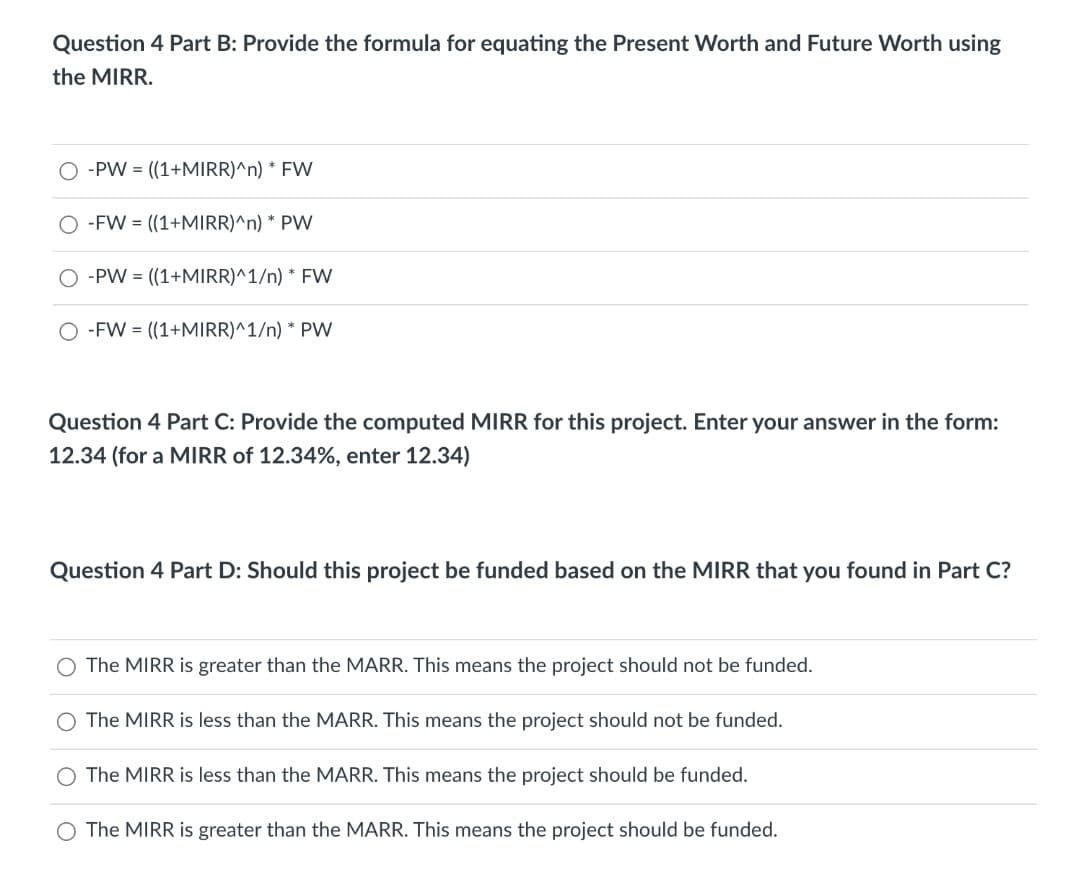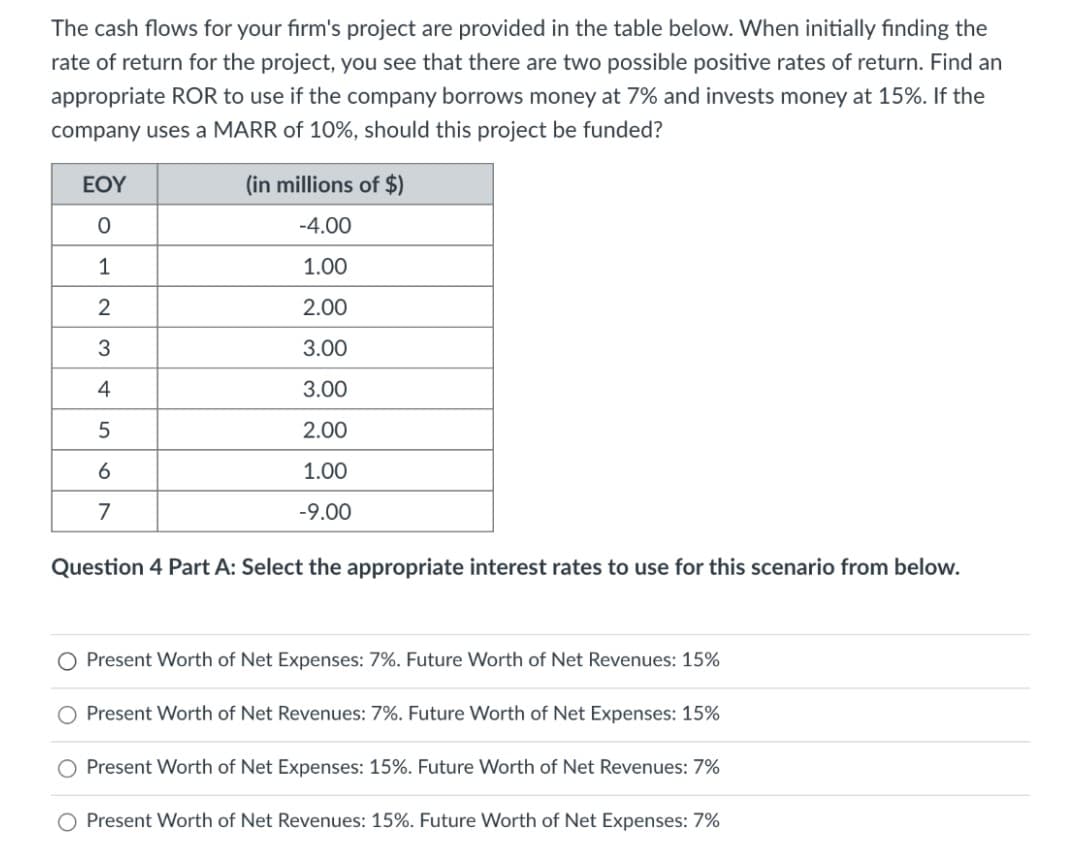The cash flows for your firm's project are provided in the table below. When initially finding the rate of return for the project, you see that there are two possible positive rates of return. Find an appropriate ROR to use if the company borrows money at 7% and invests money at 15%. If the company uses a MARR of 10%, should this project be funded? EOY (in millions of $) -4.00 1 1.00 2 2.00 3 3.00 4 3.00 2.00 1.00 7 -9.00 Question 4 Part A: Select the appropriate interest rates to use for this scenario from below. Present Worth of Net Expenses: 7%. Future Worth of Net Revenues: 15% Present Worth of Net Revenues: 7%. Future Worth of Net Expenses: 15% O Present Worth of Net Expenses: 15%. Future Worth of Net Revenues: 7% Present Worth of Net Revenues: 15%. Future Worth of Net Expenses: 7%
The cash flows for your firm's project are provided in the table below. When initially finding the rate of return for the project, you see that there are two possible positive rates of return. Find an appropriate ROR to use if the company borrows money at 7% and invests money at 15%. If the company uses a MARR of 10%, should this project be funded? EOY (in millions of $) -4.00 1 1.00 2 2.00 3 3.00 4 3.00 2.00 1.00 7 -9.00 Question 4 Part A: Select the appropriate interest rates to use for this scenario from below. Present Worth of Net Expenses: 7%. Future Worth of Net Revenues: 15% Present Worth of Net Revenues: 7%. Future Worth of Net Expenses: 15% O Present Worth of Net Expenses: 15%. Future Worth of Net Revenues: 7% Present Worth of Net Revenues: 15%. Future Worth of Net Expenses: 7%
Chapter1: Making Economics Decisions
Section: Chapter Questions
Problem 1QTC
Related questions
Question
Q. 3

Transcribed Image Text:Question 4 Part B: Provide the formula for equating the Present Worth and Future Worth using
the MIRR.
O -PW = ((1+MIRR)^n) * FW
-FW = ((1+MIRR)^n) * PW
-PW = ((1+MIRR)^1/n) * FW
O -FW = ((1+MIRR)^1/n) * PW
Question 4 Part C: Provide the computed MIRR for this project. Enter your answer in the form:
12.34 (for a MIRR of 12.34%, enter 12.34)
Question 4 Part D: Should this project be funded based on the MIRR that you found in Part C?
The MIRR is greater than the MARR. This means the project should not be funded.
O The MIRR is less than the MARR. This means the project should not be funded.
O The MIRR is less than the MARR. This means the project should be funded.
O The MIRR is greater than the MARR. This means the project should be funded.

Transcribed Image Text:The cash flows for your firm's project are provided in the table below. When initially finding the
rate of return for the project, you see that there are two possible positive rates of return. Find an
appropriate ROR to use if the company borrows money at 7% and invests money at 15%. If the
company uses a MARR of 10%, should this project be funded?
EOY
(in millions of $)
-4.00
1
1.00
2.00
3
3.00
4
3.00
5
2.00
6
1.00
7
-9.00
Question 4 Part A: Select the appropriate interest rates to use for this scenario from below.
O Present Worth of Net Expenses: 7%. Future Worth of Net Revenues: 15%
Present Worth of Net Revenues: 7%. Future Worth of Net Expenses: 15%
Present Worth of Net Expenses: 15%. Future Worth of Net Revenues: 7%
O Present Worth of Net Revenues: 15%. Future Worth of Net Expenses: 7%
Expert Solution
This question has been solved!
Explore an expertly crafted, step-by-step solution for a thorough understanding of key concepts.
This is a popular solution!
Trending now
This is a popular solution!
Step by step
Solved in 4 steps with 1 images

Knowledge Booster
Learn more about
Need a deep-dive on the concept behind this application? Look no further. Learn more about this topic, economics and related others by exploring similar questions and additional content below.Recommended textbooks for you


Principles of Economics (12th Edition)
Economics
ISBN:
9780134078779
Author:
Karl E. Case, Ray C. Fair, Sharon E. Oster
Publisher:
PEARSON

Engineering Economy (17th Edition)
Economics
ISBN:
9780134870069
Author:
William G. Sullivan, Elin M. Wicks, C. Patrick Koelling
Publisher:
PEARSON


Principles of Economics (12th Edition)
Economics
ISBN:
9780134078779
Author:
Karl E. Case, Ray C. Fair, Sharon E. Oster
Publisher:
PEARSON

Engineering Economy (17th Edition)
Economics
ISBN:
9780134870069
Author:
William G. Sullivan, Elin M. Wicks, C. Patrick Koelling
Publisher:
PEARSON

Principles of Economics (MindTap Course List)
Economics
ISBN:
9781305585126
Author:
N. Gregory Mankiw
Publisher:
Cengage Learning

Managerial Economics: A Problem Solving Approach
Economics
ISBN:
9781337106665
Author:
Luke M. Froeb, Brian T. McCann, Michael R. Ward, Mike Shor
Publisher:
Cengage Learning

Managerial Economics & Business Strategy (Mcgraw-…
Economics
ISBN:
9781259290619
Author:
Michael Baye, Jeff Prince
Publisher:
McGraw-Hill Education